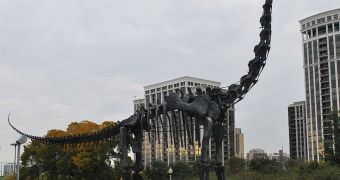For many years, scientists have been debating within the international community as to whether the largest animals to have ever lived on land kept their heads held high or not. Sauropods were a special type of dinosaurs, a group that included Brachiosaurus, Diplodocus, and Apatosaurus. These enormous creatures were only exceeded in mass and dimensions by marine creatures, and sported long necks as adaptation to having to reach upwards for food. Evidence has been brought to light that shows some of these creatures could not actually lift their heads. Now, new data seems to suggest otherwise.
There is a general consensus in the scientific community that Apatosaurus and Diplodocus could not lift their heads. The reason for this is that the energy costs of them doing so would have been too tremendous. Their hearts would have needed to pump blood to enormous heights (for a heart), and this would have taken a huge toll in terms of energy consumption. But experts say that at least a few sauropod species did indeed manage to raise their heads up. One good example is the mid-sized dinosaur called Euhelopus zdanskyi, which weighed some 8,400 pounds (3,800 kilograms). It had a length of about 36 to 39 feet (11 to 12 meters) from nose tip to tail, and researchers say it lived between 130 million and 112 million years ago, in the early days of the Cretaceous.
According to German functional morphologist Andreas Christian, who is based at the University of Flensburg, this dinosaur's head and neck weighed in excess of 210 kilograms (460 pounds) combined. Lifting this enormous weight would have normally been a challenge for its heart and energy supplies, given that the distance between the base of its neck and its snout exceeded 4.6 meters, or 15 feet. Following extensive studies of E. zdanskyi fossils, Christian concluded that the animal most likely held its head high, in a manner similar to how giraffes do today. The neck must have been inclined at a 45-degree angle from the ground, he adds, quoted by LiveScience.
This means that the dinosaur found it easy to fully raise its head for several minutes at a time, from that starting point. The new research was based on analysis of the cartilage found at the base of the sauropod's neck. The expert also discovered that the effort required to raise the head to reach high-up leaves was well worth it. The amount of food gathered in this manner justified this adaptation, as it gave no incentive for the dinosaur to move its massive body to other location, featuring lower-hanging leaves. “Distribution of food was important for the optimal feeding strategy,” Christian adds. Additional details of the discoveries appear in the June 2 online issue of the top-rated scientific journal Biology Letters.

 14 DAY TRIAL //
14 DAY TRIAL //